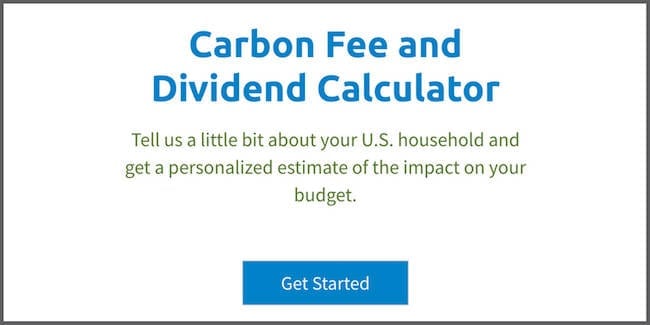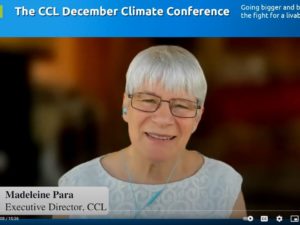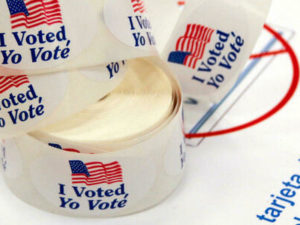By Flannery Winchester
CCL is laser-focused on encouraging Congress to pass a Carbon Fee and Dividend policy, which would price carbon emissions and return the revenue to Americans. We know from our Household Impact Study that a majority of Americans would see a net benefit from a policy like ours, but where do you yourself fall? What about the average constituent in your district?
To help you answer those questions, CCL developed the Carbon Fee and Dividend Calculator. It’s an easy-to-use online tool that estimates the financial outcome for any given household under the first year carbon fee of $15/ton. “The Household Impact Study has been such a critical asset to CCL in that it provides hard data,” said Bryan Hermsen, a volunteer in CCL’s Lincoln, Neb. chapter who was instrumental in developing the Calculator web page. “Now we have a way to take the findings from that study and present them in a more intuitive and personalized way.”
Bryan explained, “The idea that we can both fight climate change and benefit most people financially is, of course, what makes Carbon Fee and Dividend such a compelling policy. But knowing that most people come out ahead versus seeing that your family would make an extra $25 per month on the first year, are two different things. I think that anything we can do to make the benefits of CF&D more real and immediate for people is a big win, and hopefully that’s exactly what this tool will do.”
Another volunteer who worked hard on this project is Alaina Coppa, who has been a member of CCL’s Blacksburg, Va. chapter since the fall of 2016. “I helped design the UI [User Interface] and test it with CCL volunteers to ensure we were meeting our users’ expectations,” Alaina said. “This was a project I had talked about with my local CCL group in the past, so I was excited to get a chance to contribute to it. I hope the Calculator will enable citizens to understand CCL’s policy in a way that feels tangible to their personal lives.”
How it works
Rick Knight, Research Coordinator for Citizens’ Climate Education, presented a tutorial to help volunteers and the public understand how to use this tool.
You’ll need to have seven key pieces of information on hand:
- The number of adults in your household
- Number of children
- Annual household income (to the nearest thousand)
- Zip code
- What type of home you live in (house, apartment, condo, etc.)
- The number of vehicles your family drives
- The type of energy used for heating your home (natural gas, electricity, propane, etc.)
If you’d like to fine tune the Calculator’s results, you can include three more pieces of information: your average monthly costs for gasoline, electricity, and heating (if your home is heated with a source other than electricity.)
In the tutorial, Rick walks through the Calculator using a hypothetical family with two adults, one child, and an annual household income of $45,000. This imaginary family lives in a townhouse in Chicago, has one car, and heats their home with gas. When you try this for yourself, notice the links after each question that say “Explain this.” Click there for some more context around each piece of information and how it connects to the Carbon Fee and Dividend.
After inputting all that information, the Calculator crunches the numbers and breaks them down. This hypothetical family would receive an after-tax monthly dividend of $67 but would likely see $46 in increased costs from the fee. That means in the first year of Carbon Fee and Dividend, they’ll have a net benefit of $21 in their budget each month.
Rick said, “We think this tool offers a powerful way to break down the myth that any carbon pricing plan will drain the pocketbooks of everyday Americans. The Calculator shows exactly how recycling the dividend back to families lays that objection to rest.”
Ideas for using the Calculator
This tool has the potential to go far beyond just your own use. It will be handy to answer questions from friends, family, potential supporters and anyone else who needs a clearer idea of how our policy works. For example, you could run the Calculator for an average household in a particular congressional district or town, and you may use that information in a meeting with your member of Congress. You could run it for a CEO’s average employee household to help encourage them to endorse CF&D. Try it now!
Remember that not every instance will come out with a net benefit—some more affluent households or those with larger carbon footprints may see a net loss. When that happens, it’s an invitation to talk about simple swaps that person or household can make to see fewer costs from the Carbon Fee. For example, that more affluent family can go ahead and invest in an electric car, dropping their gasoline costs to zero, or perhaps they could install a high-efficiency furnace. That may be enough for them to see a net benefit from the dividend.
And of course, it won’t just be families thinking about finding low-carbon alternatives—energy companies and businesses nationwide will be doing the same thing. Eventually, they’ll be heating our homes, providing goods and services, and powering our lives in ways that emit fewer and fewer climate changing emissions.






